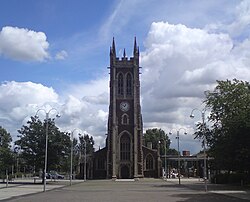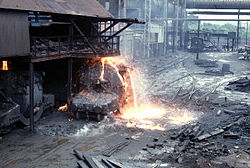Scunthorpe
| Scunthorpe | |
| Lincolnshire | |
|---|---|
 Scunthorpe Town Centre | |
| Location | |
| Grid reference: | SE893102 |
| Location: | 53°34’51"N, -0°39’1"W |
| Data | |
| Population: | 72,514 (2006) |
| Post town: | Scunthorpe |
| Postcode: | DN15 – 17 |
| Dialling code: | 01724 |
| Local Government | |
| Council: | North Lincolnshire |
| Parliamentary constituency: |
Scunthorpe |
Scunthorpe is a town in the north of Lincolnshire; the county's largest town after Grimsby and Lincoln. It is primarily an industrial town, grown on mining, steelmaking and the trade of the North Sea.
The town appears in the Domesday Book of 1086 as Escumetorp, suggesting an Old Norse derivation, perhaps from "Skuma's homestead", a site which is believed to be in the town centre close to where the present-day Market Hill is located.
Geography

Scunthorpe lies on an escarpment of ridged land, the Lincoln Edge, which slopes down towards the Trent. The surrounding environs are largely low-lying hills and plains. Although the town itself is heavily industrial it is surrounded by fertile farmland and wooded areas. In terms of general location it lies a mile east of the River Trent, 8 miles south of the Humber, 15 miles west of the Lincolnshire Wolds. The county town, Lincoln, lies 25 miles south along the Edge.
History

Scunthorpe was made up of 5 small villages. These were Scunthorpe, Frodingham, Crosby, Brumby and Ashby. They later joined up to make Scunthorpe as we know today. The town itself lies on a rich bed of iron ore and limestone, crucial in the manufacturing of steel. In 1981 it was decided to close all the local mines and quarries and outsource the iron ore from abroad, the local ore being around 20% iron and the foreign ore being 60–70% iron. At the same time, British Steel closed all its other mining operations in Britain.
Industrial history

Ironstone was mined in the area as early as the Roman occupation, but the deposits lay forgotten until the 19th century. The rediscovery of iron ore in 1859 by Rowland Winn on the land of his father, Charles, resulted in the development of an iron and steel industry and rapid population growth.[1]
Iron ore was first mined in the Scunthorpe area in July 1860. Owing to the lack of a mainline railway the ore was transferred to a wharf at Gunness (or Gunhouse), initially by cart then by a narrow gauge railway, for distribution by barge or mainline rail from Keadby. Winn knew that the best way of exploiting the iron ore fields was for a rail link to be built from Keadby to Barnetby. He campaigned tirelessly for the link; construction work started in mid-1860 and was complete in 1864. He persuaded the Dawes brothers, to whose ironworks the ore was being supplied, to build an ironworks at the site of the iron ore fields at Scunthorpe. Construction of Scunthorpe's first ironworks, the Trent Ironworks, began in 1862, with the first cast from the blast furnace being tapped on 26 March 1864.

Other ironworks followed: building of the Frodingham Ironworks began in 1864; North Lincoln Ironworks in 1866; Redbourn Hill Iron & Coal Company in 1872; Appleby Ironworks blew in their first blast furnace in 1876; and the last constructed being John Lysaght's Iron and Steelworks in 1911, with production starting in 1912. Crude steel had been produced at Frodingham Ironworks in 1887 but this proved not to be viable. Maxmilian Mannaburg came to Frodingham Ironworks in 1889 to help build and run the steelmaking plant and on the night of 21 March 1890 the first steel was tapped.
Rowland Winn is remembered in the town by three street names: Rowland Road, Winn Street and Oswald Road. He assumed the title Lord St Oswald in 1885. Nostell Road was also named after the family seat Nostell Priory.
Economy
Industry

The steel industry is still the major employer in the area and the largest operator within it is the Indian-owned firm TATA Steel. However the industry has shrunk in recent years, following the closure of the Normanby Park works (also known as Lysaght's) and the huge Redbourn complex in the early 1980s; the number employed in the industry fell from 27,000 at its height to around 4,500 plus outside contractors.
Despite this it is still the major integrated steel works in Britain. There is also a lime works nearby, involved in the production of steel. The cooling towers can be seen close to Brigg Road (A1029). Parts of the plant include the continuous casting plant and the blast furnace and rod mill. Limestone is provided by Singleton Birch at the nearby quarry in Melton Ross. Limestone is used as a flux for the blast furnace, which produces calcium silicate. TATA Steel (formerly Corus) at Scunthorpe has four blast furnaces. These blast furnaces have got names instead of numbers and are the only known blast furnaces to have names. The blast furnaces are named after four famous monarchs and are nicknamed the 'four queens'. The names of the four blast furnaces are Mary, Bess, Anne and Victoria.

Other industries in the town include those associated with the steelworks such as engineering, along with food production, distribution and retailing. BOC have a plant just north of the town next to the A1029. Near to BOC is the well established waste management firm, Bell Waste Control, which services the majority of industry in Scunthorpe and the surrounding areas. On the Foxhills Industrial Park, north of the A1077 northern bypass, are many distribution companies, notably a large building owned by the Nisa Today co-operative type mutual organisation which has its UK headquarters there. 2 Sisters have a large chicken processing plant in the town. Key Country Foods produces meat products on an industrial scale. ColepCCL manufactures aerosols for a variety of products. There are a number of other companies involved in manufacturing and light engineering.
The town has struggled to develop after the downsizing of traditional heavy industry in the 1980s and 1990s, and while the town was made a priority development area in that period no multinationals or blue chips have moved in to fill the gap – as a consequence the local labour force mainly comprises semi-skilled and unskilled labour. In the 2001 census 19.3% of the working age population were economically inactive.[2]
According to the Environment Agency in the year 2000, Scunthorpe was home to one of the biggest polluting businesses in the United Kingdom, Corus, whose sites in the town and at Llanwern and Port Talbot produced more dioxins than the next 15 biggest polluters.[3]
Culture

The North Lincolnshire Museum is on Oswald Road, near the railway station.[4] St John the Evangelist Church (built in 1891 by Lord St Oswald) in Church Square is now the 20–21 Visual Arts Centre.[5] The Plowright Theatre, named after Joan Plowright, is on Laneham Street (off the west end of High Street). It was built in 1958 as Scunthorpe Civic Theatre.[6]
Get Carter
The Mancunian writer Ted Lewis, who lived in nearby Barton-upon-Humber, featured the town in some of his novels about low-life 1960s gangster Jack Carter. The most famous of these books, Jack's Return Home saw the main character return from London to his home-town of Scunthorpe to avenge his brother's death. The story itself was based on the background to the real-life murder of Sunderland fruit machine cash collector Angus Sibbet in 1967, in what was known as the One-armed bandit murder.
The film rights to this book were purchased by MGM who transferred the setting from Scunthorpe to Newcastle upon Tyne and released the film in 1971 as the cult British crime thriller Get Carter, starring Michael Caine in the eponymous lead role. However none of the production was shot in the area, being filmed entirely on location on Tyneside. An American version more recently moved this Scunthorpe story even further afield, across the Atlantic.
References
- ↑ Rowland Winn (1820–1893)
- ↑ "Economic Deprivation", Office for National Statistics. Retrieved 24 July 2011
- ↑ Boseley, Sarah (18 May 2000). "Incinerator cancer threat revealed". The Guardian (London). http://www.guardian.co.uk/uk_news/story/0,,222158,00.html. Retrieved 9 April 2010.
- ↑ "North Lincolnshire Museum". North Lincolnshire Council. http://www.northlincs.gov.uk/NorthLincs/Leisure/museums/NorthLincolnshireMuseum.htm. Retrieved 3 August 2008.
- ↑ North Lincolnshire Council. "20 -21 Visual Art Centre". http://www.northlincs.gov.uk/NorthLincs/leisure/arts/20-21VisualArtsCentre/. Retrieved 3 August 2008.
- ↑ "Theatres". North Lincolnshire Council. http://www.northlincs.gov.uk/NorthLincs/Leisure/theatres/. Retrieved 3 August 2008.
Outside links
- This Is Scunthorpe (Scunthorpe Telegraph)
- North Lincolnshire Council
- Scunthorpe – The Heavens Reflect Our Labours, Documentary on Scunthorpe history made by local schoolchildren
- Scunthorpe on Film Part 2, Part Two of a series of 3 photo compilations depicting views of Scunthorpe
- Scunthorpe's Iron & Steel Heritage Photos showing Scunthorpe's Iron & Steel past
- Photos from the 20:21 Visual Arts Centre in Scunthorpe